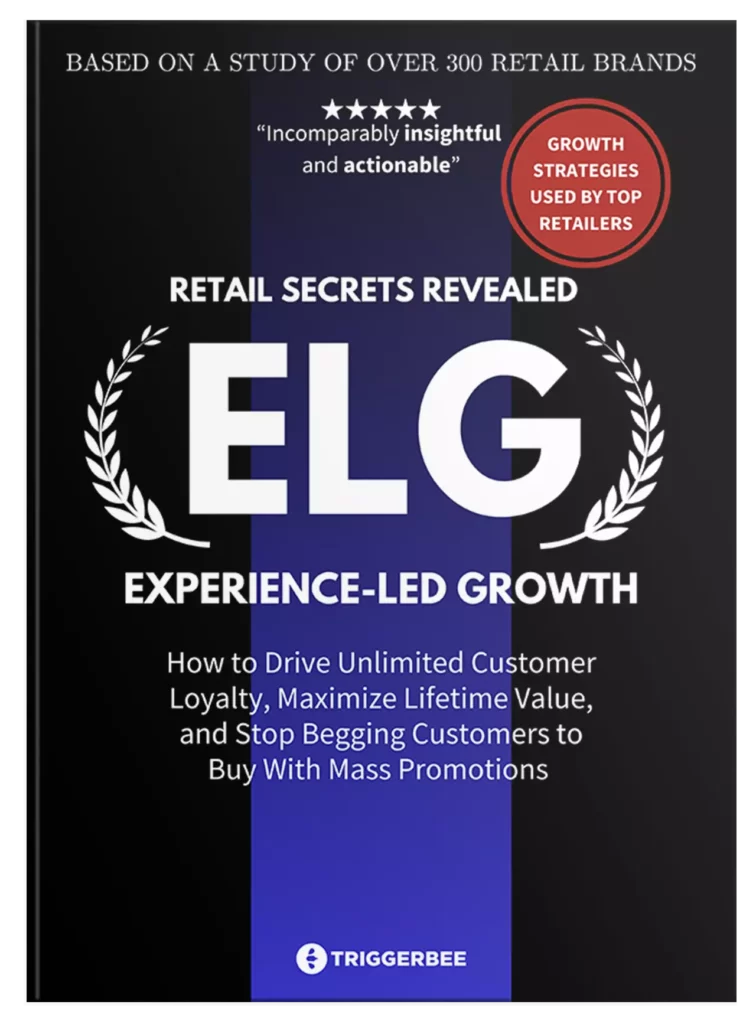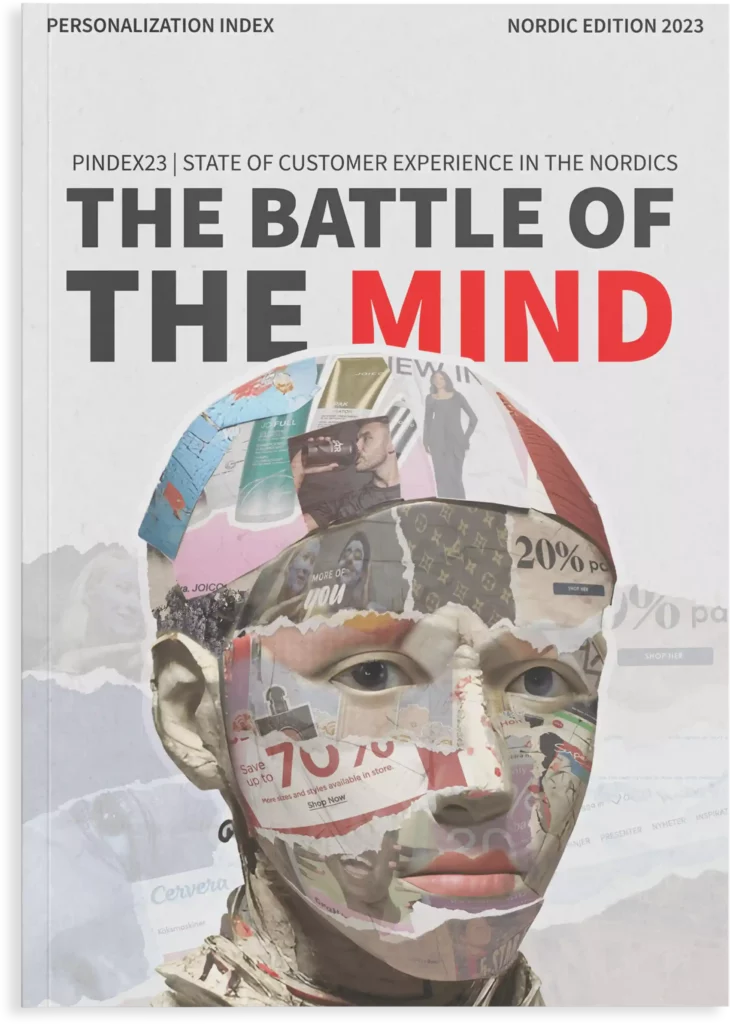What if you could get an almost instant 60% increase in customer engagement by gamifying your customer experience?
What Is Gamification Marketing?
Gamification in marketing means using games, points, and rewards to engage customers. Instead of just saying “buy now” or relying on discounts, gamified marketing campaigns can tap into powerful psychological triggers.
Here’s the deal:
Your brain releases dopamine when you play or make progress in a game. Your brain rewards you and tells you that this is a good thing to motivate you to keep playing. This keeps you hooked and it’s is why something as simple as a spin the wheel popup can feel irresistible.
Gamification also creates a “just one more try” loop. Temu has gone all in on gamification and tactics like free discount spins, progress bars, and rewards to keep customers coming back. And slot machines in casinos use random rewards to keep players spinning. Mobile games hook you with daily rewards and streaks. Both tap into dopamine-driven activities which leaves you wanting more.
The Psychology Behind Gamification and Why it Works
At its core, gamification makes tasks (such as signing up for a newsletter) feel less like work and more like a fun challenge. When people think they have a chance to win something, without risking anything, they don’t want to lose that chance. It creates curiosity, which has a huge impact on our decision making.
Pair curiosity with a nice reward and you have a super powerful recipe for increasing conversions.
Key Psychological Principles & Biases at Play in Gamification
Reciprocity Bias (Cialdini, 1984)
When people receive something they feel the need to give something in return. By offering a small reward like a discount code, you can increase the odds of someone following through with a purchase.
Endowed Progress Effect (Nunes & Drèze, 2006)
When people feel like they have already made progress toward a goal they are more likely to complete it. Think partially filled progress bars, or being a few points away from the next membership level. It makes users feel like they are on their way to earning a reward.
Loss Aversion (Kahneman & Tversky, 1979)
People have a stronger urge to keep what they already have compared to the urge they feel to gain something. Limited-time offers and expiring rewards take advantage of this bias by making users feel like they don’t want to let go of their reward.
Zeigarnik Effect (Bluma Zeigarnik, 1927)
Unfinished tasks stick in people’s minds more than completed ones. Make someone complete a simple 4×4 memory game in less than 20 seconds. If they don’t complete it, they will feel the urge to try again.
Social Proof & Competition (Festinger, 1954)
Most people don’t make decisions in isolation. They look for comfort in other’s decisions before them. Also, most people are naturally drawn to competition. Both leaderboards and social sharing take advantage of this.
How Game Mechanics Influence Behavior
| Game Mechanic | Psychological trigger | Why it works |
| Spin-to-Win Wheel | Reciprocity, Loss Aversion | Offering a chance to win makes customers feel they should give something in return, like an email or a purchase. The fear of missing out on a prize also encourages immediate action. |
| Progress Bars | Endowed Progress Effect, Zeigarnik Effect | Seeing progress already made makes people more likely to complete the task. If they leave before finishing, they remember the incomplete goal and feel the urge to return. |
| Quizzes & Trivia | Curiosity, Social Proof | Users enjoy testing their knowledge or discovering something new. Sharing quiz results on social media also taps into the need to compare and showcase achievements. |
| Points & Badges | Social Proof, Endowed Progress Effect | Visible achievements motivate users to keep earning. Seeing others with more points or badges can inspire competition and push users to engage more. |
| Memory Games | Zeigarnik Effect, Endowed Progress Effect | Matching pairs feels rewarding, and seeing how many are left to find pushes users to complete the game. Unfinished puzzles stay on their minds, making them want to return. |
| Leaderboards | Social Comparison Theory, Competition | Public rankings fuel competition and drive users to engage repeatedly. Players often check back to see if they’ve moved up or if someone has passed them. |
| Limited-Time Offers | Loss Aversion, Fear of Missing Out (FOMO) | Deadlines make users act quickly to avoid missing out. The idea of losing an opportunity feels more urgent than the idea of gaining a reward later. |
| Mystery Rewards | Curiosity Gap, Anticipation | Uncertainty creates excitement. Users continue engaging to uncover the reward, driven by curiosity and the possibility of getting something valuable. |
Why you should be using Gamification
- Higher Engagement
Thanks to the Zeigarnik Effect, once a user starts a game-driven activity, they’re more inclined to complete it, driving up dwell time on your site or app. - Stronger Brand Loyalty
Repeated positive micro-experiences like earning points or unlocking achievements creates a deeper emotional bond. A Harvard Business Review study notes that customers who feel engaged on an emotional level are more than 52% more valuable compared to those who are simply “satisfied”. - Reduced Friction
When you offer something of value (like a discount code), users tend to feel they “owe” you, or that they “owe themselves” not to let the discount go to waste. This can lower the guard for users and reduce friction of signing up. - Social Amplification
Whenever badges, high scores, or quiz results are easy to share, you can see a ripple effect of new signups and referrals. It’s sparked by the competitive or communal drive to show off achievements.
Benefits of Using Gamification in your Marketing
A well-planned gamified campaign can do more than just entertain. It can lead to higher brand awareness, repeat purchases, and deeper loyalty.
According to a study by Talon One, effective gamified promotions can drive up to a 60% increase in customer engagement. A boost in customer engagement will probably translate to more frequent purchases.
Shopify also reports that using gamification in e-commerce can greatly help reduce cart abandonment rates and boost overall conversion.
Below are the main advantages of gamification and why they matter for your brand:
Boosts conversions
Getting people to visit your site is one thing. Making them convert is another. Gamification helps you bridge that gap by tapping into the “fun factor” to keep visitors engaged longer, guiding them naturally toward the next step in your funnel.
Swedish auto service company Däckskiftarna used a Memory Game Signup Campaign where users flipped virtual cards to match images, and upon success, they received a freebie or discount. This simple, interactive element generated a 250% boost in email signups and demonstrates how simple gamification techniques can boost conversions.
Boosts Engagement
Turning your website or emails into mini adventures can keep visitors on your site longer. People aren’t just clicking; they’re exploring quizzes, spinning wheels, or solving puzzles. This deeper interaction encourages them to discover more pages and products. Quizzes in particular are a great way to boost product discovery.
Higher Retention
Gamified campaigns gives your customers a dopamine boost and in turn associate your brand with positive feelings. It’s subtle, but enough to encourage repeat visits.
By having engaging and interactive content like daily or weekly challenges, you create small but powerful motivators for customers to return. A daily spin-to-win contest, for instance, turns casual visitors into returning users who regularly check back to see if today is the day they’ll win something.
Stronger Customer Loyalty
Gamification speaks to people’s sense of accomplishment. According to Talon One, consumers are more likely to develop an emotional tie to a brand when they’re actively engaged in a playful reward system.
This is the reason why loyalty points are such a powerful motivator. These tactics can create bonds that go beyond one-time transactions and lead to word-of-mouth recommendations.
Shopify also notes that loyalty programs with tiered badges or achievements significantly increase repeat sales. It just goes to show how game-like progress markers help buyers feel that they’re truly invested in your brand.
Increased Data Collection
When people play a game and win something, even a small prize, they become more attached to that “win” and are willing to go a step further to claim or protect it.
In practice, that can translate into higher form completion rates, more personal data shared, or detailed survey participation.
Quizzes in particular are a gold mine of customer insights. As users answer questions to discover the right product or solution, they’re also telling you about their needs, preferences, and pain points.
From a marketing standpoint, this data is incredibly valuable. You can tailor follow-up emails, product recommendations, or loyalty offers based on a user’s quiz responses or game interactions.
Gamification types and tactics
There are endless ways to use game mechanics in marketing. However, most tactics fall under a few broader categories.
Spin to win
One of the simplest and most popular ways for e-commerce brands to introduce game mechanics is through a spin the wheel popup. When used right, the spin to win tactic is incredibly addicting and almost impossible for your visitors to ignore.
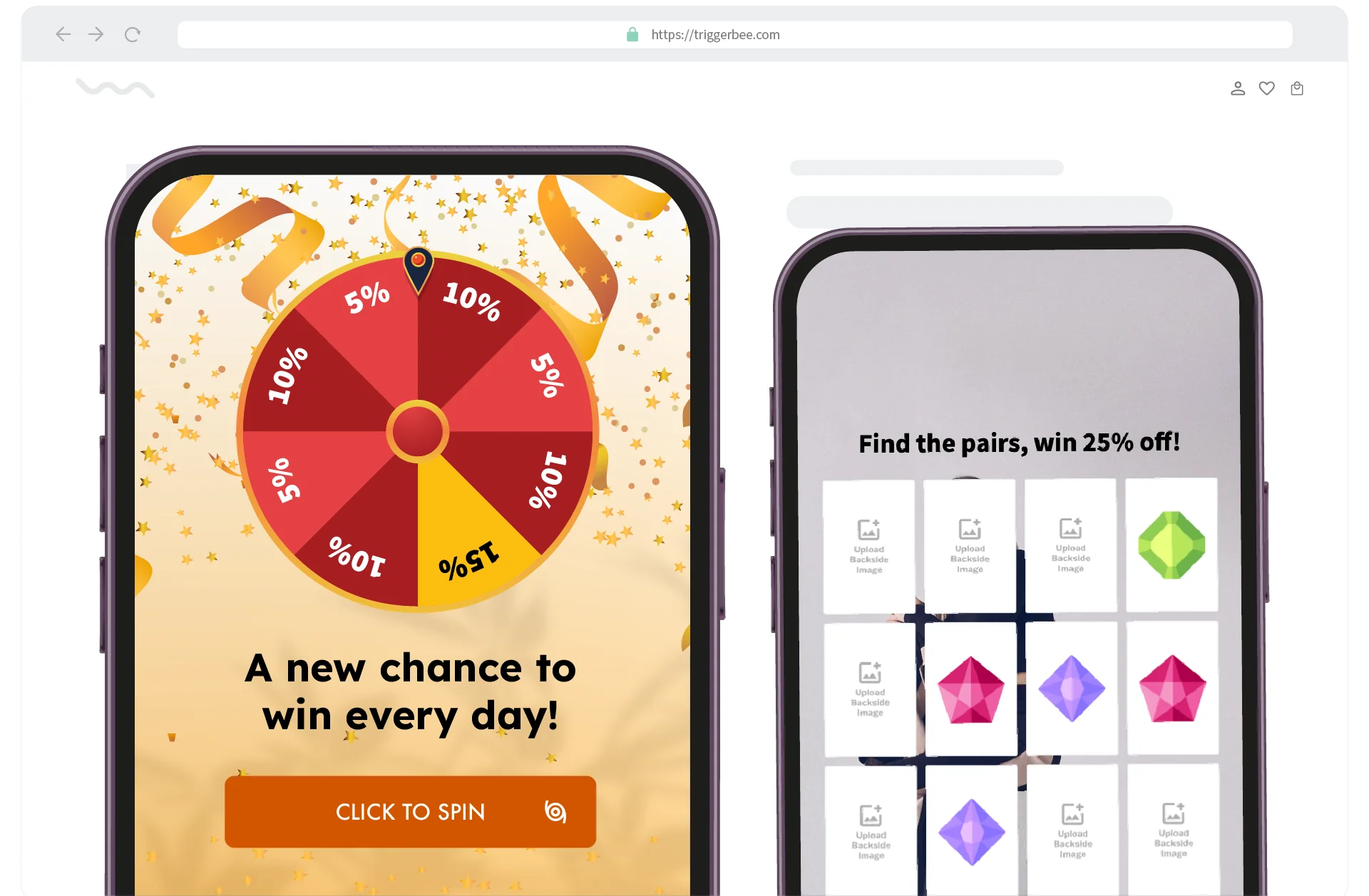
How to create your own spin the wheel promotion
Triggerbee has a very nice spin to win template which can be customized and tailored to your needs.
- Instant Reward or Email Capture
With Triggerbee you can decide whether visitors receive their reward immediately or if they must provide an email address to claim it. - Customization Options
Design the wheel with your own branding, color scheme, and prizes. You can add as many price slices as you want, control the winning percentage for each slice, and have any reward. By personalizing each part of the wheel, you can make sure it looks like your brand.
Memory Games
If you want to create longer lasting engagement, Memory games are an amazing alternative to spin the wheel popups. It’s simple, intuitive, and 9/10 users know exactly how to play without any instructions.
Visitors flip over cards to match pairs, and they get a small prize or exclusive offer when all pairs are matched.

How to create your own memory game
If you’re using Triggerbee’s onsite marketing platform, you can publish your own memory game on your website in just a few minutes as it’s a pre-made component with just a few settings to adjust.
-
- Easy Setup & Customization. Using the memory gamification campaign from Triggerbee, you can quickly adjust grid sizes (2×2, 3×3, up to 6×6) and upload your own graphics or brand-related icons to replace the standard card backs. This can help you create any type of game. Make visitors match products from your store, or match things from your company story – it’s up to you!
- Extended Engagement. Because flipping cards takes more time than a single spin, memory games naturally boost session length. Visitors often stick around to complete the puzzle.
- Random Order. We know users like to figure out the pattern of a memory, which is why our memory component always randomizes the order of the cards. So even if a user plays again the order of the cards will be completely different.
Quizzes and Trivia
Are you aiming for top-of-funnel engagement or a more helpful approach? Quizzes and trivia challenges invite your audience to showcase what they know (or think they know) in a fun, low-pressure environment.
Whether it’s “Which product fits your personality?” or “How well do you know this industry?”, quizzes help you build trust early on while collecting valuable data about user preferences.
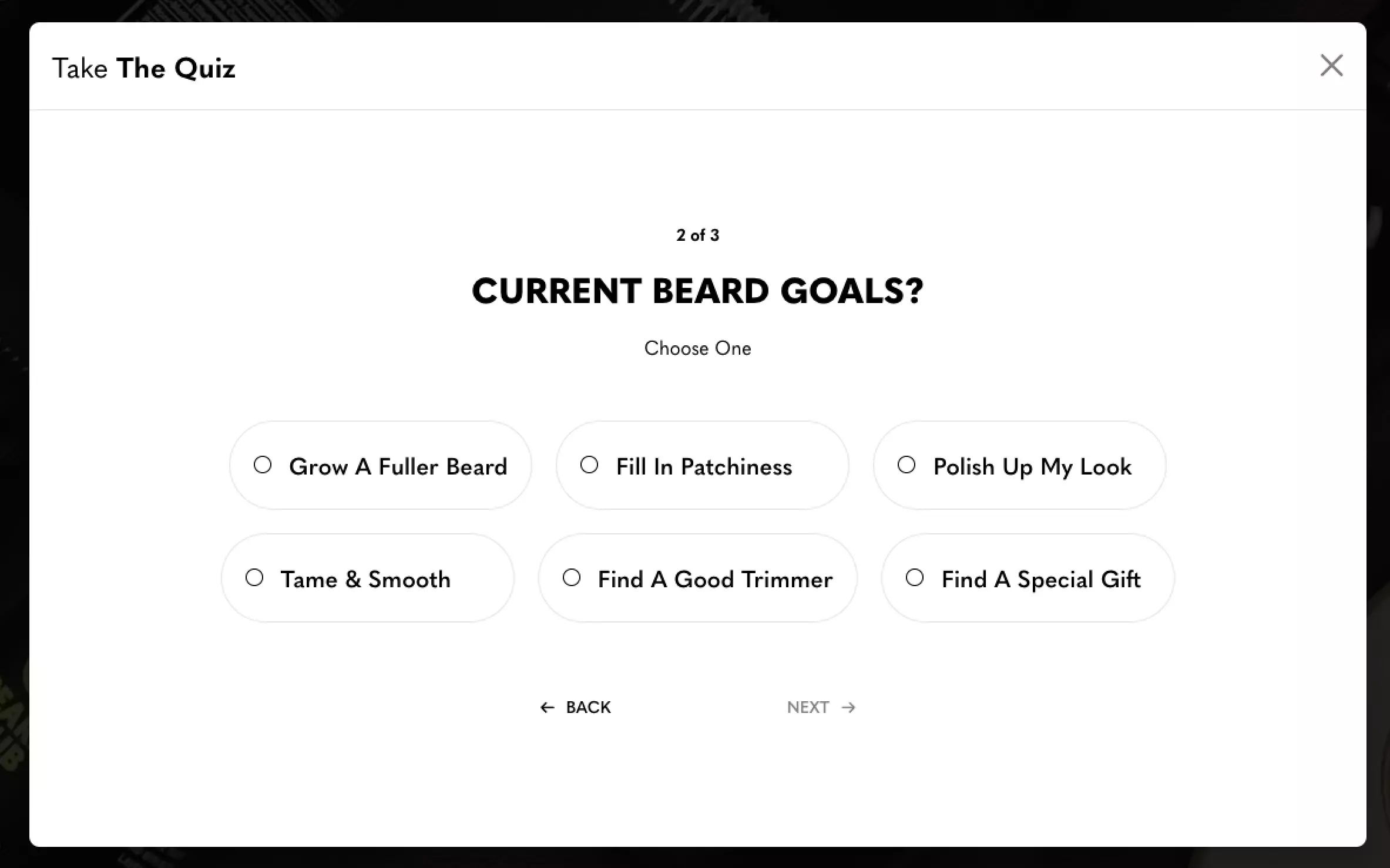
- Personalization Goldmine. Every question answered can be used to tailor recommendations or segment your audience.
- Social Sharing. Everyone loves showing off a high score or a unique personality match, so quizzes are often shared among friends and followers.
Raffles and Competitions
Looking to offer a quick boost of excitement? Raffles and competitions tap into people’s natural love of winning—whether the prize is a free product, a limited-edition item, or early access to a new collection.

This method works well in the awareness and consideration stages, generating buzz and urgency that can easily be amplified on social media.
- Quick Win Potential. A straightforward entry form, plus a grand prize, will capture leads almost instantly. Announce the winner on social channels or via email for extra hype.
- Scalable for Small or Large Campaigns. Raffles and contests can be as simple as a one-time giveaway or as complex as a multi-week challenge with different tiers of rewards. Just a tip: For your own sake, keep it simple.
Loyalty Programs
Loyalty programs reward users for repeat actions such as purchases, referrals, or social shares. And users are rewarded with extra points, badges, or VIP tiers. They’re especially effective for mid- and bottom-funnel customers who already like your brand but need extra motivation.

- Tiered Progression. Shoppers might begin at a Bronze level and advance to Silver or Gold with each new purchase. This sense of achievement can make your customers feel special and give them a reason to come back.
- Long-Term Engagement. Loyalty programs encourage ongoing interactions. However, members very rarely check their points status or track their progress. So once you’ve acquired a new member, make sure to constantly remind them of their membership status and unused points. Swedish beauty brand KICKS reminds members who return to their website about new coupons and offers. Read the case study here.
Leaderboards
Want your community to bond over competition? Leaderboards put your most active fans front and center by showcasing their achievements. This tactic works wonders for brands with active user bases (i.e gaming, fitness, or any niche where users naturally share accomplishments) and have the potential to completely transform your brand feel.
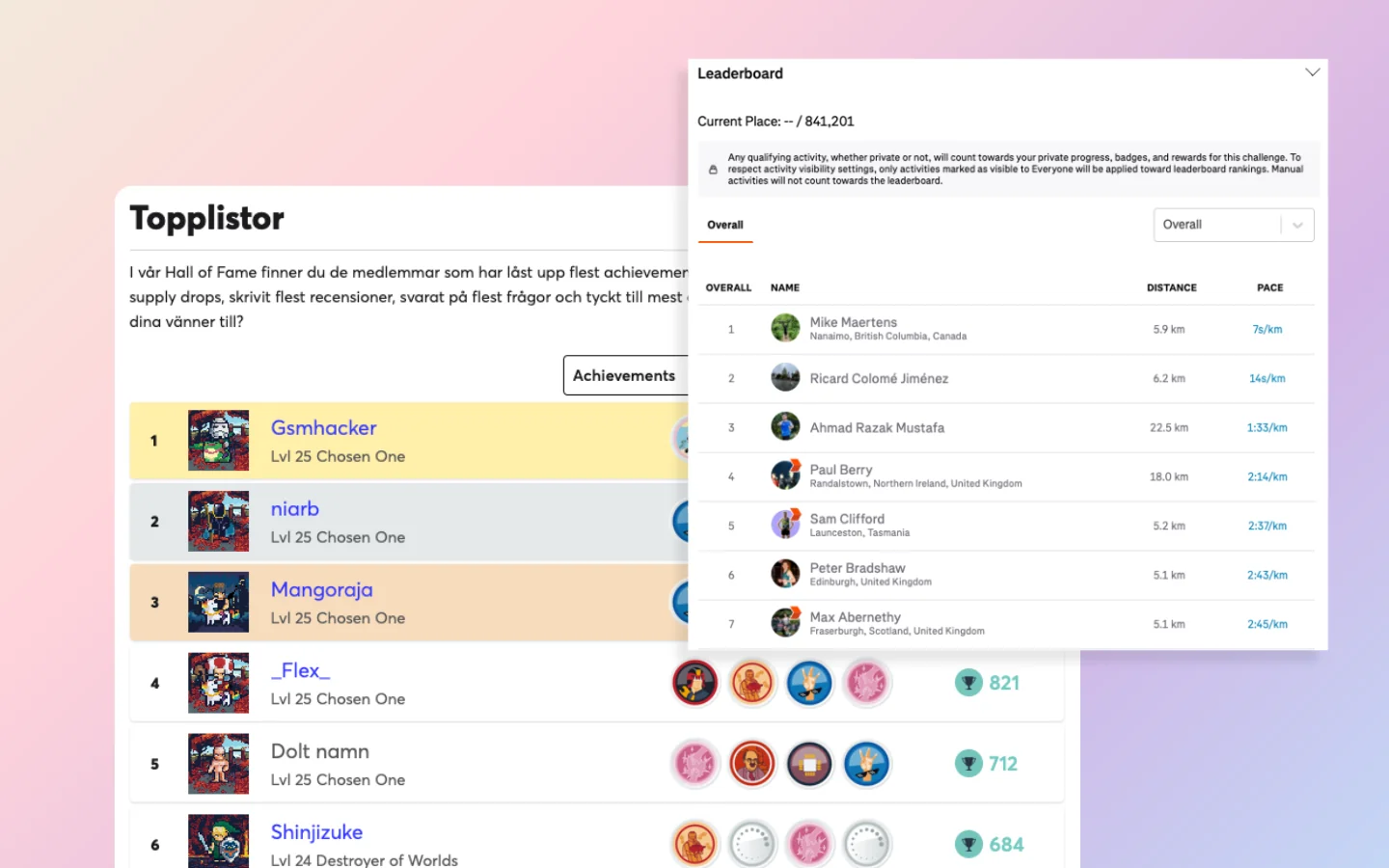
- Community Building
Publicly recognizing top performers, whether they’ve racked up the most points, written the most reviews, or referred the most friends, creates a sense of competition. - Encourages Repeat Actions
As users try to climb (or stay at) the top of the leaderboard, they frequently return to your platform. This recurring engagement can become a habit, driving sustained growth and participation.
By strategically selecting the gamification approach that fits your brand’s goals, you offer customers a fun way to interact with your business—while collecting data, driving conversions, and building long-term loyalty.
When to use Gamification and when does it become too much?
Gamification isn’t a one-size-fits-all approach. You’ll get the best results by aligning the right mechanics with a specific user group or funnel stage.
That means you should plan your strategy around use cases (like boosting signups or cart conversions) or audience segments (new vs. returning visitors, loyal customers, etc.).
Below are some practical examples of how your brand can use gamification in various stages of the customer experience.
By Use Case
- To Get More Email Signups
Use a Spin-to-Win popup for first-time visitors. The excitement of spinning for a prize makes people more likely to enter their email so they don’t miss out. - To Increase Immediate Sales
Offer a spin-the-wheel game with an instant reward that doesn’t require an email. Giving users something right away, like a discount or free shipping, makes them feel like they should return the favor by completing their purchase. - In the Shopping Cart
Add a progress bar to show how close customers are to unlocking free shipping or a discount. Seeing their progress encourages them to add more to their cart instead of leaving the site. - After a Purchase
Keep customers engaged by offering loyalty points for completing a survey or sharing their purchase on social media. You can also bring them back with a weekly Memory Game that includes a leaderboard. Seeing others compete makes users more likely to return and play again.
By Audience Segment
- New Visitors
Welcome first-time visitors with a Spin-to-Win popup to grab their attention right away. Since they’re new, require an email signup so you can turn their curiosity into a lead. - Returning Visitors
If someone has visited multiple times but hasn’t bought anything, adjust the spin-the-wheel game in their favor by offering a bigger discount or a free gift. This extra push can turn a hesitant visitor into a paying customer. - Loyalty Members
Reward your most dedicated customers with exclusive games like a VIP-only raffle or a tiered Memory Challenge. You can also give loyalty points for playing, making their engagement feel even more valuable. - Dormant or “Lost” Customers
If someone hasn’t made a purchase in 6 to 12 months, bring them back with a fun challenge. A daily “Wheel of Deals” or bonus points for completing a quiz or memory game can reignite their interest. Even a small win can remind them why they loved your brand in the first place.
When does gamification become too much?
Gamification is a powerful tool, but like anything else, too much of it can backfire. Imagine eating pizza every day. It’s exciting at first, but after a while, you get tired of it. The same thing happens when users are constantly hit with popups, spin wheels, points, badges, leaderboards, and timers. What starts as fun and engaging quickly turns into sensory overload.
Take Temu as an example. Their entire platform is built on gamification and constant dopamine triggers. Flash deals, spin-to-win popups, countdown timers, referral rewards, in-app credits, and daily check-ins all compete for attention at the same time.
But here’s the thing: it works for them. Say what you will about their aggressive marketing, but they have over 92 million monthly active users in the EU alone—meaning millions of people return to their app at least once a month.
That doesn’t mean it will work for you.
Unless your brand is built around constant gamification, going from 0 to 100 overnight would likely drive your customers crazy.
So, how do you strike the right balance?
- Use gamification sparingly and with purpose. Instead of stacking multiple game elements on one page, choose one or two key moments in the customer journey where it makes sense, like a spin-the-wheel popup for new visitors or a loyalty challenge for repeat customers.
- Keep the experience simple. A progress bar for free shipping or a fun memory game once in a while keeps engagement high without overwhelming users.
- Avoid constant interruptions. If every interaction feels like a game, it WILL start to feel like a chore. Let your customers browse and shop without feeling like they need to “unlock” something every few seconds.
Gamification should enhance your user experience, not take it over. If customers start to feel like they’re navigating an arcade rather than an online store, it’s time to scale back.
The Anatomy of Well-Designed Gamification Marketing
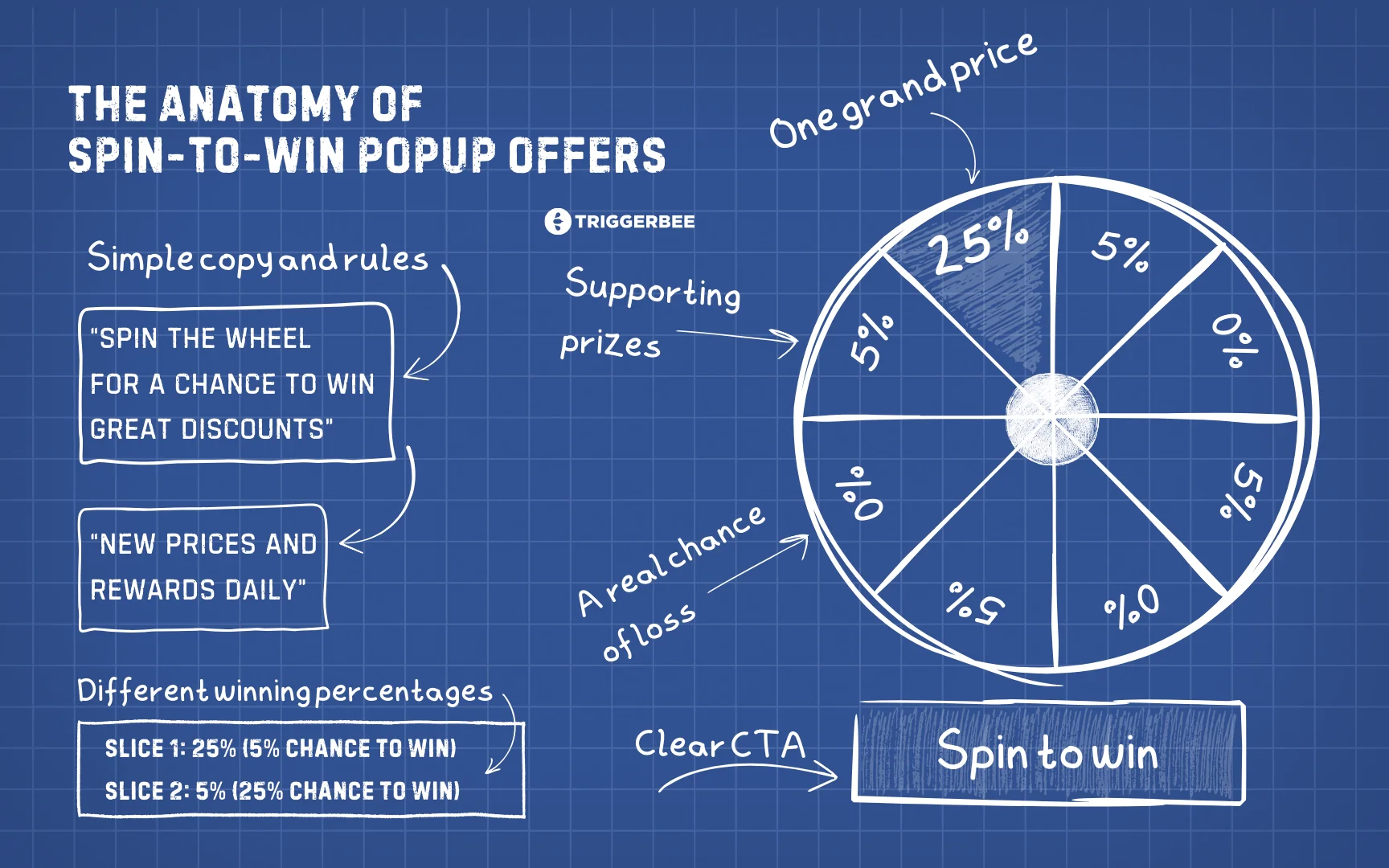
Think of a gamified campaign as a puzzle. Each component should fit neatly with the others to create a seamless, enjoyable experience for your audience.
- User-Friendly Mechanics
A Spin to Win-popup should not have rules and too many prizes. Keep your tactics and rewards straightforward and visually appealing. - Motivating Rewards
The prize doesn’t have to be huge. It just needs to feel relevant and exciting to your audience. - Progress Indicators
Let participants see how far they’ve come. Whether it’s a progress bar or a dynamic points count, visible progress makes them more likely to stay and keep going. - Fair Rules and Transparency
If you are running a competition, clearly outline how winners are chosen, how points are tallied, and which data you’re collecting. Clear communication builds trust.
Compliance Considerations
Gamification must be done ethically and transparently. While playful mechanics can increase conversions, misleading tactics or unclear data practices can damage trust and even lead to legal trouble. Here’s what to keep in mind when integrating gamification into your marketing strategy.
GDPR and Data Privacy Compliance
If your gamification campaign collects user data you must comply with data privacy laws like GDPR (General Data Protection Regulation) in the EU and CCPA (California Consumer Privacy Act) in the U.S.
To stay compliant:
- Clearly disclose what data you collect and how it will be used. If a spin-the-wheel game requires an email, be upfront about whether they’ll receive marketing emails afterward.
- Give users a choice. Make sure users opt in to data collection rather than being automatically enrolled.
- Allow easy opt-out options. If users later decide they don’t want to receive promotional emails or be part of your loyalty program, make unsubscribing simple and accessible.
A lack of transparency can lead to fines, legal complaints, and, most importantly, a loss of trust from your audience.
Avoid Manipulative Game Mechanics
Gamification should feel fun and rewarding. Not a high-pressure sales tactic. Overusing competitive pressure, creating unrealistic expectations, or making it difficult for users to claim their rewards just creates a bad experience.
Here’s what to avoid:
- “Fake scarcity” tactics: If your countdown timer resets every time a visitor refreshes the page, users will eventually catch on to that.
- Complicated reward structures: If users need to jump through multiple hoops to redeem a simple prize, they will end up feeling frustrated and scammed.
- Surprise fees or conditions: If a user wins a discount or freebie, ensure the terms are clear upfront. Hidden fees or exclusions will backfire.
Personalization in Gamification
Gamification works best when it feels relevant to the user. Not all customers respond to the same incentives, so a one-size-fits-all approach may not deliver the best results. By tailoring game mechanics to different segments, you can create a more engaging and meaningful experience that drives conversions and long-term loyalty.
Segmented Rewards
Different types of customers should receive different types of rewards. Repeat buyers are already invested in your brand, so offering them higher-value prizes or exclusive perks makes them feel appreciated and keeps them coming back. First-time visitors, on the other hand, might not need a big reward to take action. A small but appealing discount can be enough to encourage them to make an initial purchase.
Example:
- New visitors spin a wheel for 5% or 10% off.
- Returning customers spin a wheel with larger discounts, free shipping, or bonus loyalty points.
- VIP customers or loyalty members get access to exclusive gamified experiences, such as raffles with bigger prizes or early access to special sales.
Dynamic Difficulty
Not every user wants the same level of challenge. A first-time visitor may prefer a simple, easy-to-complete game, while a more engaged or competitive customer might be motivated by something harder to win.
Example:
- A beginner quiz asks three easy questions and rewards participation.
- A returning visitor faces more complex trivia or problem-solving tasks for better rewards.
- A loyalty program member gets tiered challenges where harder tasks unlock bigger prizes.
By adjusting the difficulty based on a user’s experience level, you keep them engaged without frustrating newcomers or boring experienced users.
Personalized Rewards and Recommendations
People engage more when they feel a brand understands them. Instead of offering random prizes, use past browsing behavior or purchase history to shape the rewards. This makes the experience feel customized rather than generic.
Example:
- A customer who frequently shops for skincare might win a discount on beauty products instead of a general storewide coupon.
- Someone who recently browsed athletic gear might see a fitness-themed challenge or reward.
- A returning customer who buys seasonal items could be invited to a holiday-themed gamified campaign based on their past purchases.
When gamification feels personal, customers are more likely to participate and take action. Instead of a gimmick, it becomes a valuable and enjoyable part of their shopping experience.
Amazing Examples of Gamification
Many brands have successfully used gamification to increase engagement, build loyalty, and encourage repeat behavior. These examples show how different industries apply game mechanics to create a more interactive and rewarding experience for their users.
Temu: Turning Shopping Into a Game
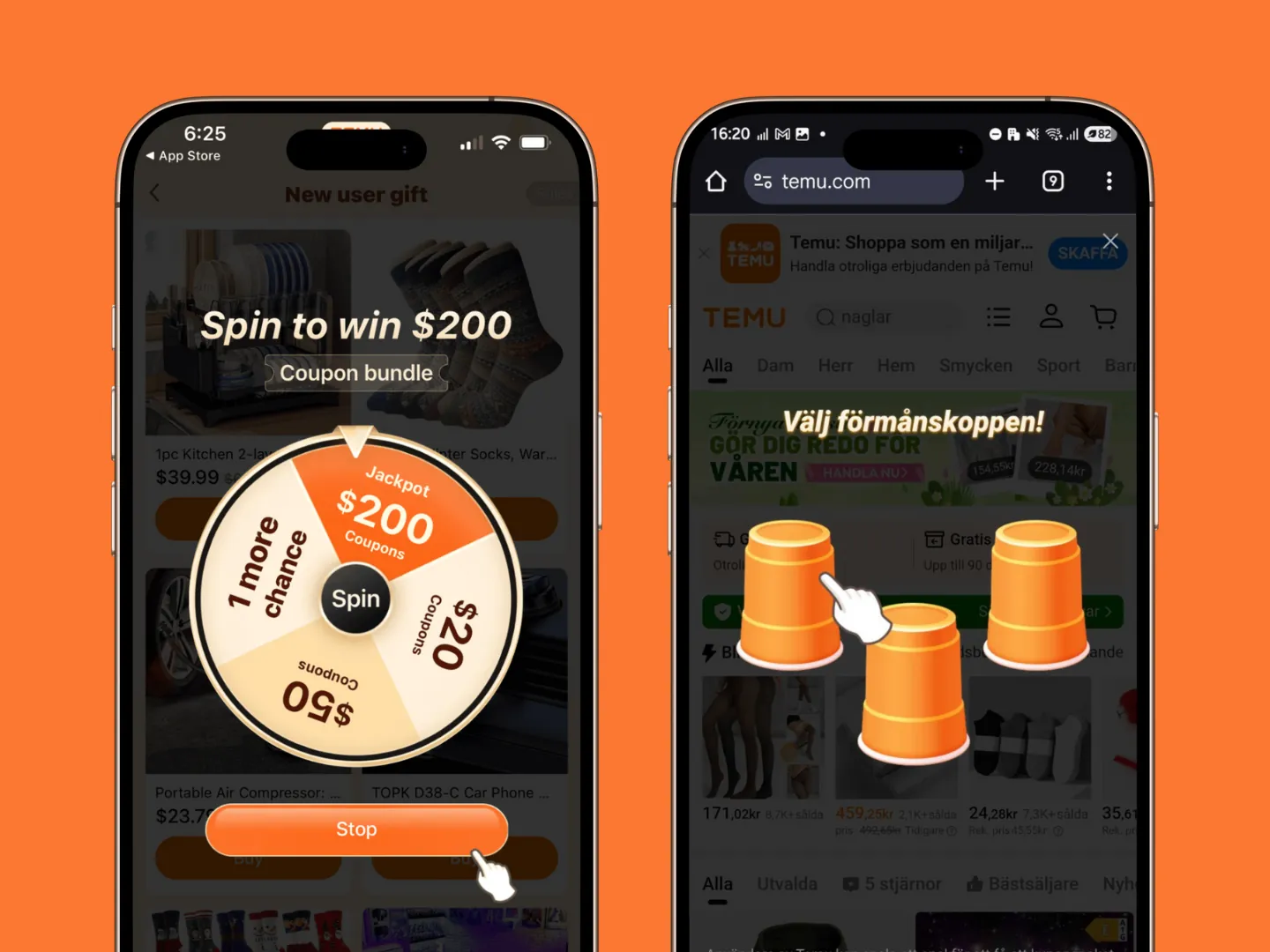
Temu integrates gamification throughout its app, keeping users engaged with interactive challenges, daily rewards, and referral-based incentives. Customers can earn credits or free products by completing small tasks, such as inviting friends, spinning a wheel, or checking in daily. The constant stream of achievable goals encourages shoppers to return frequently, increasing both retention and overall spending.
Strava: Competing for Fitness Goals
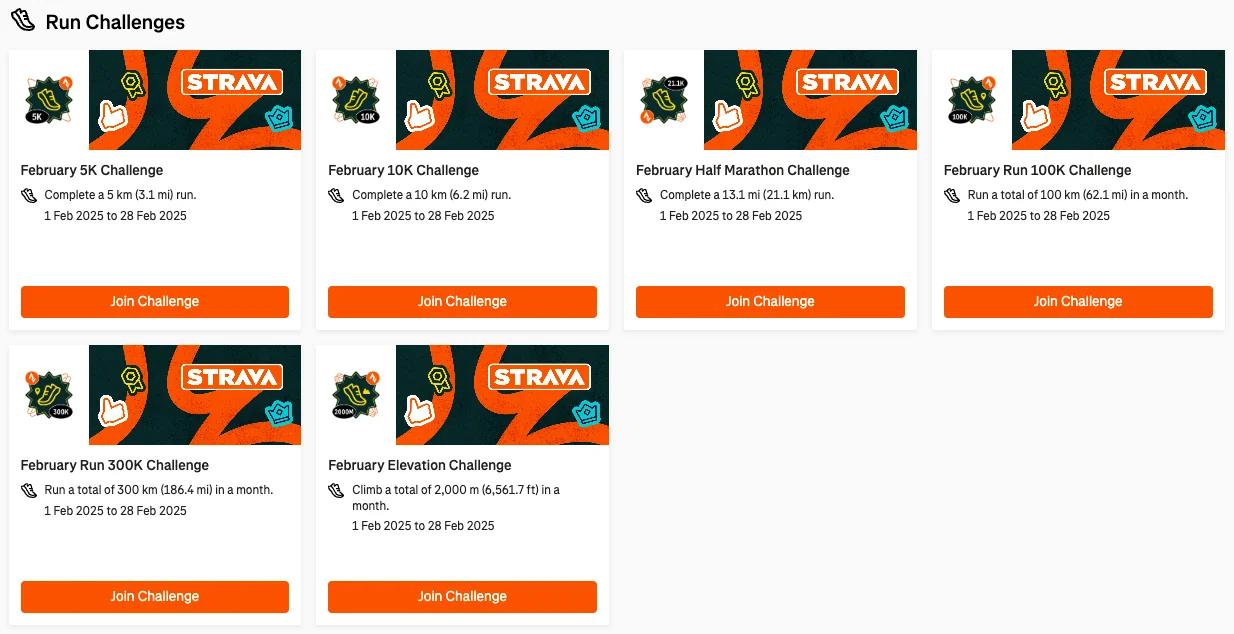
Strava has built a thriving fitness community by using competition and achievement-based rewards. Runners and cyclists can track their progress, compare times with friends, and challenge themselves through leaderboard rankings. Monthly challenge badges provide an extra layer of motivation, giving users a sense of accomplishment and encouraging them to stay active. By tapping into social proof and friendly competition, Strava keeps users engaged long after their initial sign-up.
Duolingo: The Power of Streaks and Progress Bars
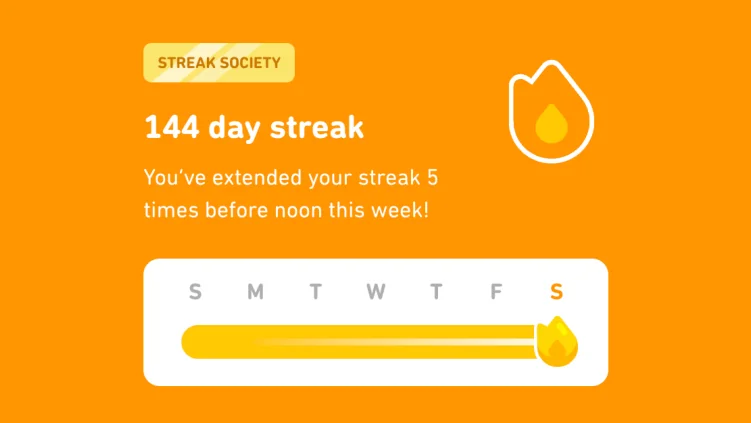
Duolingo makes language learning feel like a game by incorporating progress tracking, daily streaks, and reward-based feedback. Users earn points and level up as they complete lessons, reinforcing the habit of daily practice. The streak feature plays on loss aversion, making users more likely to return each day to avoid breaking their progress. The simple act of seeing a streak number grow can be enough to keep users engaged for months or even years.
Starbucks: A Loyalty Program That Feels Like a Game
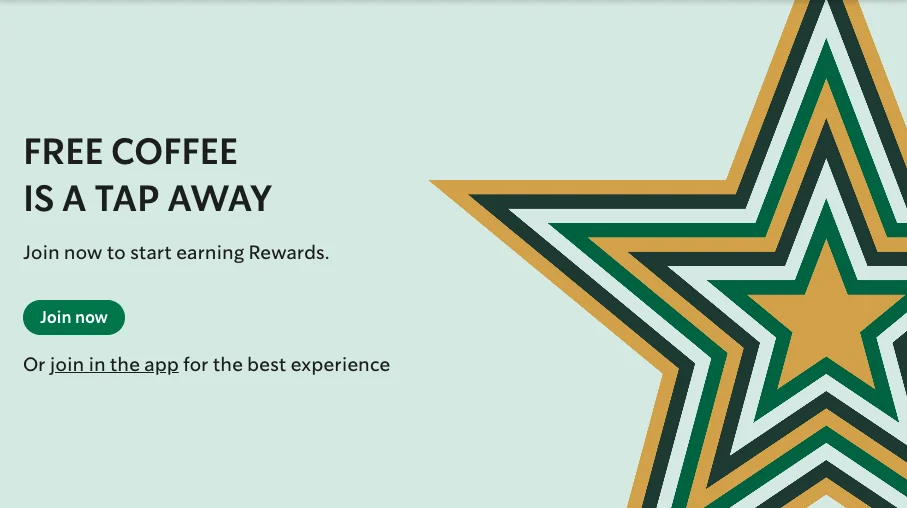
Starbucks has perfected the use of gamification in its Star Rewards loyalty program. Every purchase earns stars, which can be redeemed for free drinks or food. Customers can track their progress, unlock bonus challenges, and earn extra rewards for limited-time promotions. The system encourages repeat visits by creating a sense of progress and rewarding users for continued engagement. Unlike traditional discount programs, the star system makes earning rewards feel like an achievement rather than a transaction.
Each of these brands has successfully applied gamification by understanding what motivates their audience. Whether it is social competition, daily habits, or the excitement of earning rewards, they use game mechanics to create engaging and repeatable experiences that keep users coming back.
Gucci: Entering Roblox
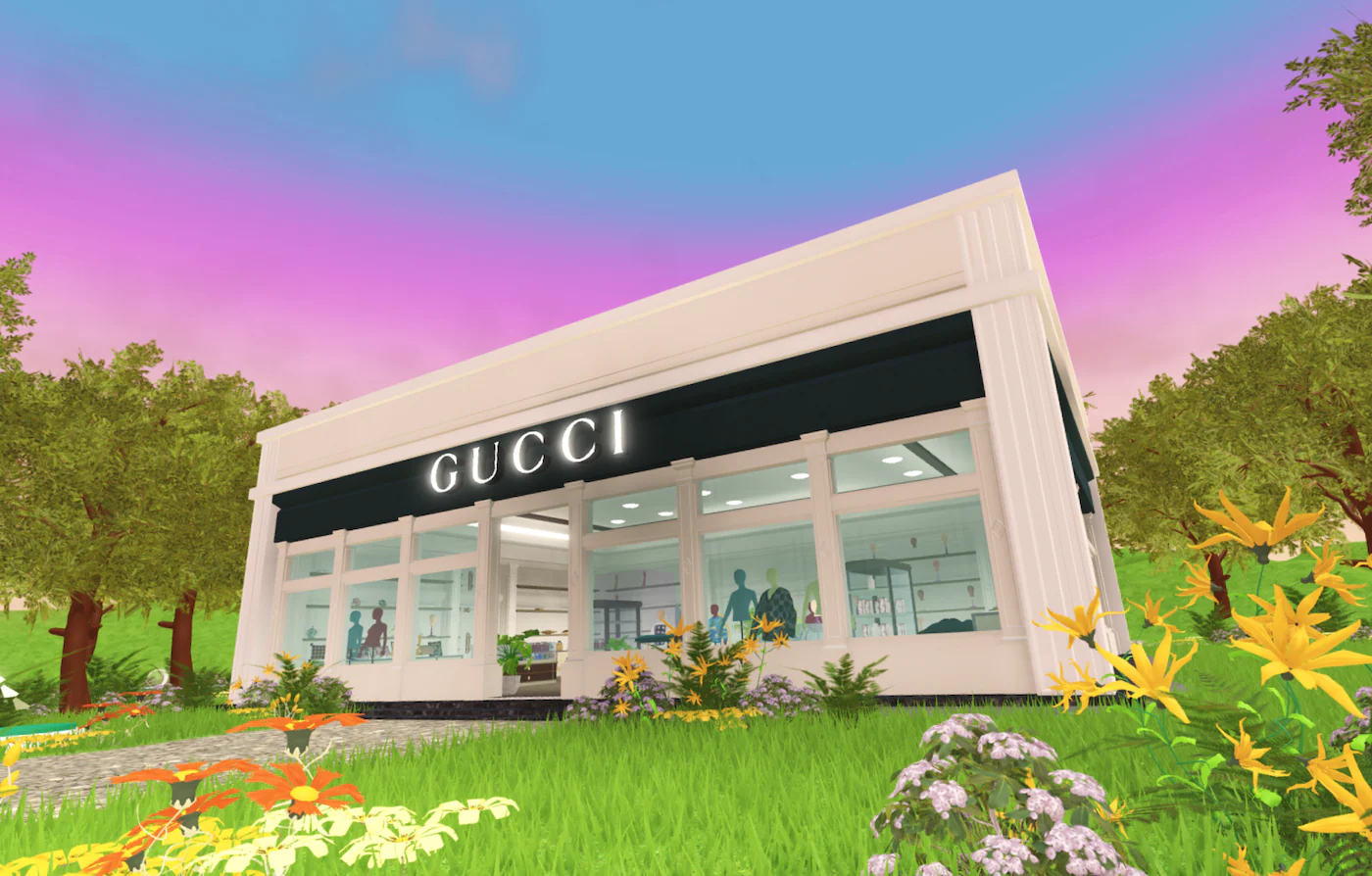
Gucci has taken gamification to a new level by integrating its brand into Roblox, a popular virtual world with millions of active players. Instead of relying on traditional marketing, Gucci created Gucci Town which is an interactive virtual space where users can explore, play mini-games, and collect digital fashion pieces for their avatars.
This gamified experience taps into digital ownership and brand exclusivity, two trends shaping the future of online engagement. Players can earn in-game currency to purchase limited-edition Gucci items, engage in virtual art exhibitions, and even complete challenges to unlock special rewards.
Wrapping It Up
Gamification goes beyond short-term hype by turning brand interactions into playful adventures. It engages visitors, nurtures them through multiple touchpoints, and can boost loyalty in a way traditional marketing rarely matches. According to a Deloitte study, 66% of consumers prefer brands that incorporate playful elements into their user experience, so this isn’t a fleeting trend.
Remember to track ROI, stay transparent about data, and continuously refresh your game elements to keep them exciting. With powerful tools like Triggerbee—and a dash of creativity—you can shape a brand journey that feels like an ongoing quest. Try these ideas in your own funnel and see how they level up your key KPIs.
